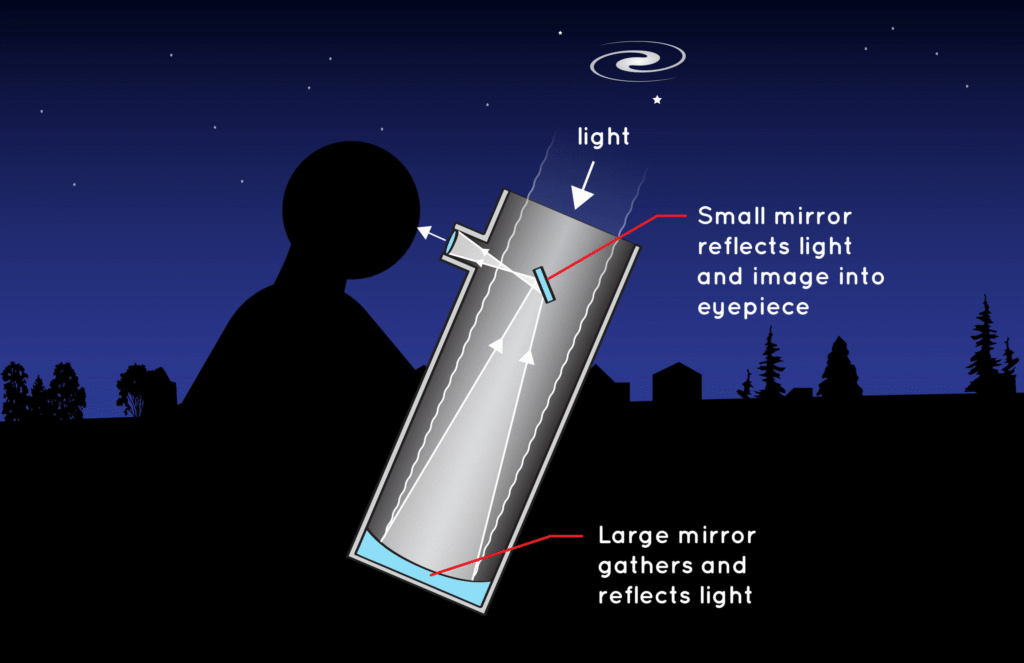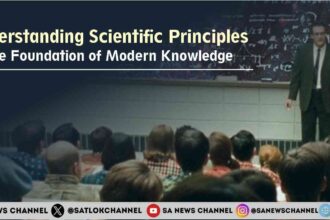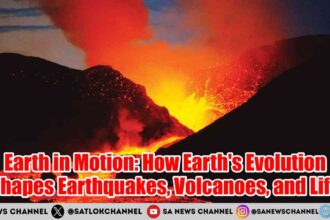A space telescope is a powerful astronomical observatory placed outside Earth’s atmosphere, either orbiting our planet or traveling deeper into space. Unlike ground-based telescopes, these orbiting instruments avoid the distortions caused by Earth’s atmosphere—like clouds, dust, pollution, and turbulence. This means they can take incredibly sharp and accurate images of celestial objects such as stars, galaxies, black holes, nebulae, planets, and even distant exoplanets.
- Why Do We Need Telescopes in Space?
- Key advantages of a space telescope
- How Space Telescopes Work
- Types of Space Telescopes
- Famous Space Telescopes Around the World
- Hubble Space Telescope (NASA/ESA)
- James Webb Space Telescope (NASA/ESA/CSA)
- Chandra X-ray Observatory
- Spitzer Space Telescope
- ISRO’s Contribution to Space-Based Telescopes
- Future Indian Space Telescopes
- AstroSat-2
- INSIST (Indian Spectroscopic and Imaging Space Telescope)
- ExoWorlds Mission
- Why ISRO’s Space Telescopes Matter Globally
- What We’ve Learned from Space Telescopes
- The Future of Space Telescopes
- Challenges of Operating Telescopes in Space
- Benefits of Space Telescopes for Humanity
- Conclusion: Looking at the Universe Through Powerful Eyes
- Have Saints Seen God and Returned? A Perspective Beyond Telescopes and Stars
- FAQs: Space Telescopes
- Q1. What is a space telescope?
- Q2. How is a space telescope different from a regular telescope?
- Q3. What are the most famous space telescopes?
- Q4. What has the Hubble Space Telescope discovered?
- Q5. What is the James Webb Space Telescope used for?
- Connect With Us on the Following Social Media Platforms
The concept of placing a telescope in space was proposed decades ago by astronomers who knew that Earth’s atmosphere limits how much we can see. Since then, space telescopes have become some of the most important tools in astronomy and telescopes research, giving scientists new insights into the structure, formation, and history of the universe.
Why Do We Need Telescopes in Space?
The Earth’s atmosphere blocks many kinds of light, such as ultraviolet (UV), X-rays, and gamma rays. That means ground-based telescopes can’t observe certain events or objects in space, especially those that emit these high-energy wavelengths. Also, air movements and light pollution blur images captured from the ground.
A telescope in space avoids all these problems by observing from outside the atmosphere. As a result, it offers scientists a much clearer and broader view of the universe.
Key advantages of a space telescope
- Sharper and more detailed images without atmospheric interference
- Access to all types of light: visible, ultraviolet, infrared, X-rays, and gamma rays
- No impact from weather, day-night cycles, or pollution
- Allows continuous observation of objects in space
- Makes it easier to detect faint or distant sources of light
How Space Telescopes Work
Space telescopes work by collecting light or radiation from distant cosmic objects and converting that information into data that scientists can study. Since these telescopes operate in the vacuum of space, they need to be extremely reliable, automated, and capable of working without physical repairs for many years.

Basic Parts of a Space Telescope
- Primary mirror or lens: Captures and focuses incoming light or radiation from space
- Detectors and scientific instruments: Convert the collected light into digital signals
- Solar panels: Generate energy by transforming sunlight into electricity
- Thermal control systems: Keep sensitive parts at the right temperature
- Pointing and control systems: Help the telescope aim accurately at specific targets
- Communication systems: Send data back to Earth and receive commands from scientists
Space Telescopes vs Ground-Based Telescopes
| Feature | Space Telescope | Ground-Based Telescope |
| Location | Orbits Earth or travels through space | On Earth’s surface |
| Image quality | Very high (no atmospheric distortion) | Lower (affected by atmosphere) |
| Light range | Full range: visible, UV, infrared, X-rays, gamma rays | Mostly visible and radio |
| Maintenance | Not possible or very rare | Easier to upgrade and repair |
| Operating time | Can observe continuously | Limited by daylight and weather |
| Cost | Expensive to build and launch | More affordable |
Types of Space Telescopes
Various kinds of space telescopes are made to observe different types of light or radiation. Each type focuses on specific parts of the electromagnetic spectrum, helping scientists study different aspects of the universe.

Optical Space Telescopes
These detect visible light, the same kind of light humans can see. They are used to take detailed images of stars, galaxies, nebulae, and planets.
- Example: Hubble Space Telescope
Infrared Telescopes
These detect infrared radiation, which is a form of heat. They are ideal for seeing through cosmic dust clouds and observing distant, cold objects like forming stars or ancient galaxies.
- Example: James Webb Space Telescope
X-ray and Gamma-ray Telescopes
These detect high-energy radiation from extreme cosmic events such as supernovae, black holes, and neutron stars.
- Examples: Chandra X-ray Observatory, Fermi Gamma-ray Space Telescope
Famous Space Telescopes Around the World
Hubble Space Telescope (NASA/ESA)
- Initiated in 1990 by NASA and the European Space Agency (ESA)
- Orbits about 547 km above Earth
- Captured famous images like the Pillars of Creation and deep field galaxies
- Assisted in figuring out the age and growth rate of the universe
- Provided data that revolutionized astronomy
James Webb Space Telescope (NASA/ESA/CSA)
- Launched in 2021; created by NASA, ESA, and the Canadian Space Agency (CSA)
- Designed to observe infrared light with extreme sensitivity
- Fitted with a big gold-coated mirror measuring 6.5 meters across
- Can observe the past to view the first galaxies and stars
- An essential instrument for examining exoplanets and their atmospheres
Chandra X-ray Observatory
- Launched by NASA in 1999
- Focused on detecting X-rays from extremely hot and energetic cosmic phenomena
- Helped scientists study black holes, galaxy clusters, and cosmic explosions
Spitzer Space Telescope
- Launched in 2003 and retired in 2020
- Specialized in infrared astronomy
- Discovered many exoplanets and studied the early stages of star formation
ISRO’s Contribution to Space-Based Telescopes
India’s space agency, ISRO, has achieved significant advancements in creating affordable and scientifically important space telescopes. These initiatives place India among the select countries investigating the universe from space.
Also Read: The History of Exploration: From Ancient Voyages to Outer Space
AstroSat is India’s inaugural dedicated multi-wavelength space telescope, which ISRO launched on September 28, 2015. It was intended to observe celestial objects across X-ray, optical, and ultraviolet spectral ranges at the same time.
Key Scientific Objectives:
- Investigate high-energy processes in binary star systems containing neutron stars and black holes.
- Estimate magnetic fields of neutron stars.
- Study star formation regions and high-energy phenomena in galaxies beyond the Milky Way.
- Detect new transient X-ray sources in the sky.
- Perform a thorough survey of the universe in the ultraviolet range.
Instruments Onboard:
AstroSat carries five scientific payloads:
- UVIT (Ultraviolet Imaging Telescope) – Observes in near and far ultraviolet bands.
- SXT (Soft X-ray Telescope) – Researches soft X-ray emissions from cosmic sources.
- LAXPC (Large Area X-ray Proportional Counter) – Detects high-energy X-rays.
- CZTI (Cadmium-Zinc-Telluride Imager) – Captures hard X-ray emissions.
- SSM (Scanning Sky Monitor) – Watches the sky for temporary X-ray sources.
AstroSat has provided valuable insights into black holes, neutron stars, and galaxy evolution, making significant contributions to astrophysical research.
XPoSat (X-ray Polarimeter Satellite)
India’s space agency, ISRO, launched XPoSat on January 1, 2024. This is India’s first satellite built to study X-rays from space. Scientists use it to learn about black holes, neutron stars, and galaxies by checking how X-rays behave.
Main Goals
- Study how X-rays are polarized, which helps scientists understand their source and nature.
- Observe about 40 bright objects, including black holes and neutron stars.
- Help scientists explore how cosmic radiation works in space.
Important Parts of XPoSat
- POLIX – Measures how X-ray light is polarized, including its direction and strength.
- XSPECT – Studies X-ray timing and energy to give more details about cosmic sources.
Why It’s Special
- Provides new information on X-ray behavior in space.
- Works alongside other missions like NASA’s IXPE.
- Helps scientists improve their understanding of space.
XPoSat is expected to work for five years, helping India and the world learn more about the universe.
Future Indian Space Telescopes
AstroSat-2
- A follow-up to AstroSat, India’s first space-based observatory.
- Expected to improve multi-wavelength observations.
- Will focus on X-ray, ultraviolet, and optical astronomy.
INSIST (Indian Spectroscopic and Imaging Space Telescope)
- Designed for high-quality imaging and spectroscopy.
- Will study stars, galaxies, and cosmic phenomena.
- Aims to enhance India’s role in space-based astronomy.
ExoWorlds Mission
- Proposed to study exoplanets and their atmospheres.
- Will help understand planet formation and habitability.
- Expected to contribute to global exoplanet research.
Why ISRO’s Space Telescopes Matter Globally
- Cost-efficient: Delivers high-value science on lower budgets
- Global partnerships: Works with NASA, ESA, and other institutions
- Scientific leadership: Expands India’s role in space exploration
What We’ve Learned from Space Telescopes
Discovering Galaxies and Nebulae
- Captured deep images of galaxies from billions of years ago
- Revealed how galaxies are born and evolve
- Noticed nebulae—cosmic clouds made of gas and dust—where stars come into existence
Studying Black Holes and Cosmic Explosions
- X-ray telescopes have tracked black hole activity and powerful cosmic jets
- Detected gamma-ray bursts and the aftermath of supernovae
- Helped confirm theories related to gravitational waves
Searching for Exoplanets
- Spitzer, Kepler, and James Webb have discovered thousands of exoplanets
- Some are in the habitable zone, raising hopes for finding life
- Analyzed exoplanet atmospheres for signs of water and organic molecules
The Future of Space Telescopes
Next-Gen Missions: Roman Space Telescope, LUVOIR
Nancy Grace Roman Space Telescope
- Scheduled for launch in the late 2020s
- Wide field of view (100x larger than Hubble)
- Will investigate dark matter, dark energy, and exoplanets
LUVOIR (Large UV Optical Infrared Surveyor)
- Conceptual mission under NASA
- May feature a massive mirror (up to 15 meters wide)
- Aims to study Earth-like exoplanets in greater detail
New Technologies in Telescope Design
- Foldable mirrors: Compact and efficient designs for launch
- Advanced cooling: Helps infrared telescopes operate at very low temperatures
- AI algorithms: Improve image processing and target selection
- Lighter materials: Reduce weight and cost of launches
Challenges of Operating Telescopes in Space
Cost and Launch Risks
- Very expensive to design, build, and launch
- Technical failures can jeopardize entire missions
- Launch delays are common due to the complexity of systems
Maintenance and Limited Lifespan
- Most cannot be repaired after launch
- Mechanical parts may wear out or malfunction
- Eventually deplete fuel or lose communication with Earth
Benefits of Space Telescopes for Humanity

Education and Curiosity
- Beautiful space images inspire people across the world
- Encourage students to explore science, math, and engineering
- Used in educational materials and science museums
Science and Technological Advancement
- Leads to new technologies, including those used in health care and industry
- Advances our understanding of physics and the universe
Global Collaboration in Astronomy
- Many missions are joint efforts between countries
- Promote peaceful cooperation in science and exploration
- Encourage the exchange of ideas and discoveries
Conclusion: Looking at the Universe Through Powerful Eyes
From the iconic Hubble Space Telescope to the futuristic James Webb and ISRO’s cutting-edge Astrosat, space telescopes have expanded our understanding of the cosmos like never before. These instruments serve as our eyes in the sky, allowing us to look deep into space and time.
With upcoming missions like LUVOIR, Roman, and Isro’s, the future of space telescopes is bright. As technology advances and international cooperation grows, humanity will continue to uncover the secrets of the universe.
Whether you are a curious student, a teacher, or a space enthusiast, the journey of astronomy and telescopes reminds us that we are all connected to the stars.
Have Saints Seen God and Returned? A Perspective Beyond Telescopes and Stars
In the age of powerful space telescopes like the James Webb Space Telescope (JWST), humanity is peering deeper into the universe than ever before. These modern marvels can observe galaxies billions of light-years away, uncovering secrets about the origin of the cosmos, black holes, exoplanets, and more.
Scientists and astronomers are on an endless quest to understand the beginning, structure, and fate of the universe. Yet, despite all this technological progress, one question remains untouched by even the most powerful instruments:
Has anyone truly seen God?
According to Sant Rampal Ji Maharaj, this question has already been answered—not by science, but by spiritually realized saints who were taken to Satlok, the eternal abode of Supreme God Kabir Sahib, and then sent back to guide humanity.
While telescopes reveal the outer universe, spiritually enlightened saints like Sant Garibdas Ji Maharaj, Sant Dharamdas Ji, and even Guru Nanak Dev Ji experienced the inner universe—the divine reality that lies beyond physical space. Garibdas Ji described Satlok as a realm full of divine light, where God resides in human-like form—an experience no telescope can capture. Similarly, Guru Nanak Dev Ji declared after his divine experience, “Satpurush Kabir is the Supreme God.”
Where science searches through instruments, these saints journeyed inward through true spiritual knowledge (Tatvgyan) granted by God Kabir Sahib Himself. Sant Rampal Ji Maharaj teaches that the real telescope to see God is not an optical device, but Naam Diksha (initiation) from a Tatvdarshi Sant, and a life of scripture-based devotion (Satbhakti).
In essence, telescopes show us distant stars, but saints like Garibdas Ji, Dharamdas Ji, and Sadana Ji have seen the Supreme Source behind all creation—God Himself. And unlike scientists, they didn’t just observe—they returned to tell the world how to reach Him.
So while the space telescope helps us see what God created, the true saints help us see the Creator Himself.
FAQs: Space Telescopes
Q1. What is a space telescope?
A space telescope is an astronomical device located in outer space to view celestial bodies. Unlike telescopes on Earth, it bypasses atmospheric disturbances, resulting in clearer and more detailed images.
Q2. How is a space telescope different from a regular telescope?
Space telescopes function beyond Earth’s atmosphere, which obstructs or distorts many light wavelengths. This enables space telescopes to view the universe in ultraviolet, infrared, and X-ray light—capabilities that ground-based telescopes struggle with.
Q3. What are the most famous space telescopes?
The most recognized include the Hubble Space Telescope, James Webb Space Telescope (JWST), Chandra X-ray Observatory, and Spitzer Space Telescope. Each one observes the universe in various light wavelengths.
Q4. What has the Hubble Space Telescope discovered?
Hubble has contributed to determining the universe’s age, observed far-off galaxies, captured supernova images, and offered insights into black holes and dark energy.
Q5. What is the James Webb Space Telescope used for?
JWST is intended to explore the early universe, the formation of stars and galaxies, and the atmospheres of exoplanets in search of life signs.









